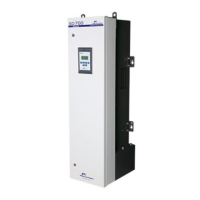
Do you have a question about the Power Electronics SD700 and is the answer not in the manual?
| Rated AC Power | 700 W |
|---|---|
| Rated AC Voltage | 230 V |
| Rated AC Current | 3.04 A |
| Output Power | 700W |
| Waveform | Pure Sine Wave |
| Input Voltage | 12V DC |
| Output Voltage | 230V |
| Frequency | 50 Hz |
| Efficiency | 90% |
| Protection | Overload, Over temperature, Short circuit |
Guidelines for proper wiring and cable management to ensure safe operation and prevent damage.
Steps to verify all parameters and signals before initial operation of the drive.
Important guidelines for safe operation, including restart functions and manual overrides.
Instructions for correct grounding of the drive and associated cabinets for safety and EMC.
Details on the removable keypad, its LEDs, LCD screen, and basic control keys.
Explanation of the four-line LCD display, its status, visualization, and programming lines.
Description of the function and operation of individual and combined control keys.
Table detailing drive status codes, their screen display, and associated meanings.
Table listing warning codes, their screen display, and descriptions of potential issues.
Parameters for displaying motor status like speed, frequency, voltage, current, and torque.
Parameters for displaying drive status such as input voltage, frequency, bus voltage, and temperatures.
Parameters for displaying analogue inputs, outputs, and digital input/output status.
Parameters showing internal drive status like fault codes, software version, and PID feedback.
Parameters that can be adjusted for speed, pressure, and inch speeds, offering user adjustments.
Registers for general drive information, including running time counters and energy consumption.
Registers providing general information about the rectifier bridge, such as input power and phase currents.
Configuration options including parameter locking, password settings, and language selection.
Parameters for entering motor specifications from its nameplate for optimal performance.
Settings for selecting speed and torque reference sources, including keypad, analogue inputs, and multi-references.
Configuration of digital and analogue inputs for control and sensor signal processing.
Parameters for setting acceleration and deceleration ramp times for smooth motor speed changes.
Parameters for setting speed, current, and torque limits to protect the motor and drive.
Configuration of various protection features for voltage, current, speed, and input power.
Information on how to view and manage fault history, including fault codes and their descriptions.
Configuration parameters for various communication protocols like Modbus, Profibus, CANopen, and Devicenet.
Parameters related to the rectifier bridge, including Vdc reference, Cos Phi, and PID control.
Details on Modbus functions supported by the drive for data reading and writing.
Explanation of different addressing modes used in Modbus communication.
Functions for controlling the drive remotely via communication network commands.
Table providing a summary of Modbus addresses for programming parameters and status registers.
Detailed list of inverter bridge faults, their possible causes, and recommended actions.
A comprehensive list of inverter bridge faults with their potential causes and solutions.
A comprehensive list of rectifier bridge faults with their potential causes and solutions.
Configuration for controlling start/stop and setting speed reference using the keypad.
Configuration for terminal control of start/stop and analogue input for speed reference.
Configuration for terminal control of start/stop and motorized potentiometer for speed reference.
Configuration for terminal start/stop and digital inputs for selecting seven speed references.